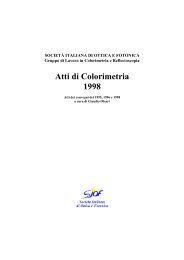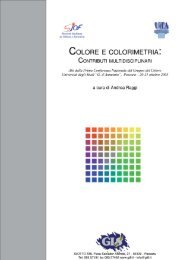Scarica gli atti - Gruppo del Colore
Scarica gli atti - Gruppo del Colore
Scarica gli atti - Gruppo del Colore
You also want an ePaper? Increase the reach of your titles
YUMPU automatically turns print PDFs into web optimized ePapers that Google loves.
R(<br />
λ)<br />
= E<br />
⎡<br />
2 ⎤ ⎡<br />
2<br />
⎛ λ − λ<br />
⎤<br />
min ⎞<br />
⎛ λ − λmin<br />
⎞<br />
⎢ ⎜ − E5<br />
⎟ ⎥ ⎢ ⎜ − E8<br />
⎟ ⎥<br />
⎢ ⎝ L ⎠ ⎥ ⎢ ⎝ L ⎠ ⎥<br />
+ E4<br />
exp⎢−<br />
⎥ + E7<br />
exp⎢−<br />
2<br />
2 ⎥<br />
⎢ E6<br />
⎥ ⎢ E9<br />
⎥<br />
⎢<br />
⎥ ⎢<br />
⎥<br />
⎣<br />
⎦ ⎣<br />
⎦<br />
152<br />
0<br />
⎡ ⎛ λ − λmin<br />
⎢ ⎜ − E<br />
⎢ ⎝ L<br />
+ E1<br />
exp⎢−<br />
2<br />
⎢ E3<br />
⎢<br />
⎣<br />
2<br />
⎞<br />
⎟<br />
⎠<br />
2<br />
⎤<br />
⎥<br />
⎥<br />
⎥ +<br />
⎥<br />
⎥<br />
⎦<br />
where the unknowns are the weights E0, E1, E4, and E7, the mean terms E2, E5,<br />
and E8, and the terms E3, E6, and E9 correlated with the standard deviation.<br />
4. Genetic algorithms<br />
Genetic algorithms (GA) are a general method for solving optimization problems,<br />
inspired by the mechanisms of evolution in biological systems (see e.g. 12, 13 for<br />
an introduction to GA and their applications). In the basic genetic algorithm, every<br />
candidate solution is represented by a sequence of binary, integer, real, or even<br />
more complex values, called an individual. A number of individuals are randomly<br />
generated as an initial population. The GA then iterates a procedure that produces a<br />
new population from the current one, until a given "STOP" criterion is satisfied. At<br />
each iteration, the value of a suitable "fitness" function is computed for every<br />
individual in the current population; the goal of the GA is to generate an individual<br />
with the best value of fitness. Given the problem described in Section 2, and<br />
assuming that only a triplet of tristimulus values is available, fitness is the squared<br />
sum of the perceptual differences between the CIELab values computed on the<br />
input color and those computed on the estimated reflectance spectrum, plus a term<br />
of range violation, with no perceptual meaning, to account for the bounds the<br />
solution must respect in order to match physical reflectance properties:<br />
* * 2 * * 2 * * 2<br />
[ L − L ) + ( a − a ) + ( b − b ) ] + δ ( R(<br />
λ))<br />
+ δ ( R(<br />
λ))<br />
fitness = (9)<br />
( input , Ill<br />
input,<br />
Ill<br />
input,<br />
Ill Ill 1<br />
2<br />
where δ<br />
⎡ ⎤<br />
1(<br />
( λ))<br />
= 1 max(<br />
( λ))<br />
−100<br />
⎢⎣ λ<br />
⎥⎦<br />
R D R iff )) ( ( max R λ >100, else 0<br />
λ )) ( ( δ1 R λ = and<br />
δ ( λ))<br />
min(<br />
( λ))<br />
D R = −<br />
iff )) ( ( min R λ





